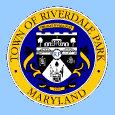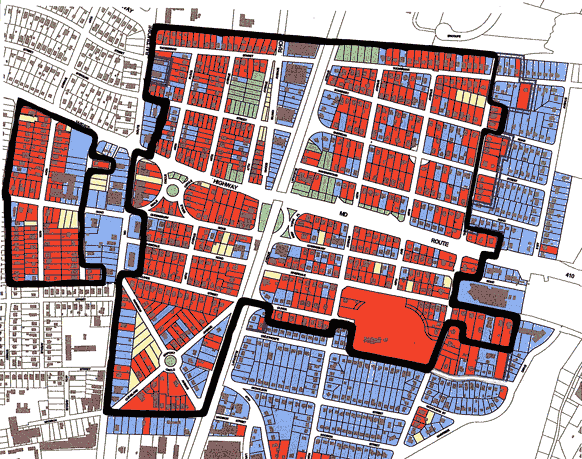
Historic Districts Proposed for Riverdale Park, Part II
No Rules for Homeowners
At the November 5 Legislative Meeting, the Riverdale Park Town Council voted to pursue seeking two National Register Historic Districts: West Riverdale and Riverdale Park (see map below).

Click here for high-resolution (750 kB!!) version of this map
[These maps are generated from a combination of draft maps from 1/14/2001 and 10/26/2001. Check with the town office before assuming they are correct. Color code: orange is contributing building, blue is non-contributing building, green/yellow have no buildings, thick black lines are the borders of the districts. -- webmaster]
An October 25 presentation and slide show by Howard Berger, architectural historian with the M-NCPPC, and Laura Trieschmann, architectural historian with EHT Traceries, the firm that prepared our nomination packet, explained that Riverdale Park qualified under two of the four possible criteria set up by the U.S. Department of the Interior. The town is "associated with events that have made a significant contribution to the broad patterns of our history" (meaning Riversdale and Charles Benedict Calvert, who founded the Maryland Agricultural College-now the University of Maryland-and was instrumental in the formation of the U.S. Department of Agriculture) and also "embodies the distinctive characteristics of a type, period, or method of construction or represents the work of a master, or possesses high artistic values. . . " (meaning our architecture and community development).
At the presentation, which was attended by about 40 residents and broadcast live over the town's cable channel (and rebroadcast several times since then), one question was on the tip of everyone's tongues-What are the rules? The answer may surprise you.
No Rules for Homeowners. . .
When most people think of the words "historic district," they picture arcane rules and unfriendly review boards. Although there are types of districts-even homeowner associations--that dictate paint colors and building materials, a National Register District does not have these. Instead of protecting individual homes, a National Register District is designed to protect entire neighborhoods. So, the rules apply to other governments. For example, it is very difficult to expand a highway or build a landfill in a National Register District. For Riverdale Park, these are important considerations.
So, we can still paint our houses to suit our own tastes, repair roofs using the latest in materials, and build additions for our expanding families. If you didn't need a permit for the work before, you will not need it in a National Register District.
Unless You Want to Apply for Tax Benefits
The federal government is currently considering expanding its tax breaks to private homes in National Register Districts; these already exist for commercial buildings. However, the state already offers rebates on your state income tax, but only for approved historically sensitive or accurate work. See http://www.dhcd.state.md.us for more information. The rebates may change from time to time; a more comprehensive explanation will appear in the Town Crier next year, as we move toward acceptance of our nomination.
Next Steps in the Process
The Prince George's County Planning Board will be reviewing our application in December and, if all goes well, the state will hear our case in February. The Planning Board's meeting is Tuesday, December 18, 7:00 (please call for the room location in the County Administration Building in Upper Marlboro, 301-952-3520), and residents are encouraged to attend. The town will be testifying in support of the nomination.
A final decision on whether we will receive this honor should be made by summer 2002. We could be seeing our brown "historic district" signs by this time next fall.
Chris Davis, Ward 4 Councilmember, is president of the Preservation Association of Riverdale Park. For more information, call 301-277-6615, or email cdavis@apa.org.
This page was last changed on Saturday, January 12, 2002. Questions, comments, or submissions? See the Website Committee web page. This page has been accessed [an error occurred while processing this directive] times.